Travel and Tourism Sector
VerifiedAdded on 2023/04/03
|11
|3109
|484
AI Summary
This report discusses the key historical developments, structure, and implications of political changes in the travel and tourism sector. It also explores the factors affecting tourist demands and strategies to meet the demand. The report focuses on the TUI group and its role in the development of the sector.
Contribute Materials
Your contribution can guide someone’s learning journey. Share your
documents today.
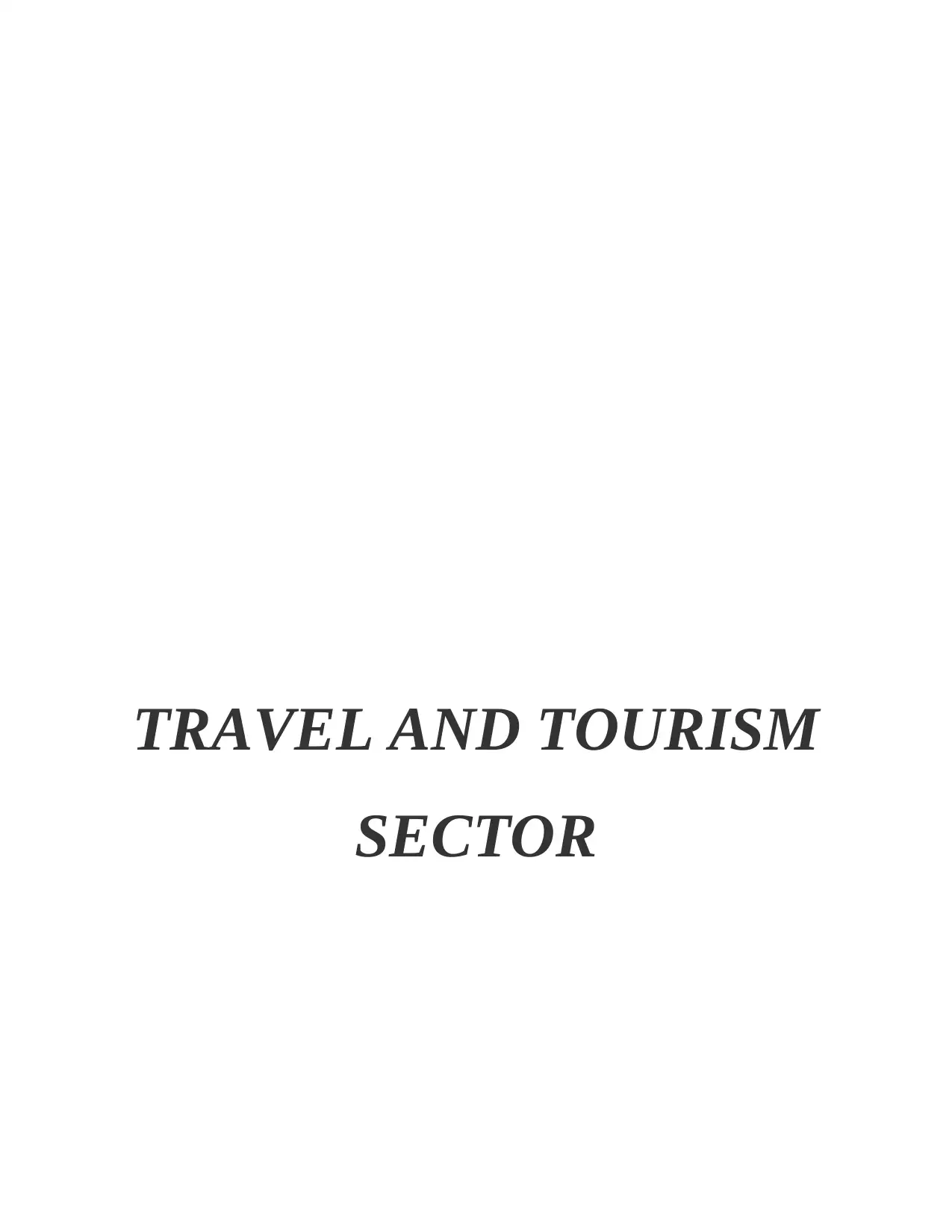
TRAVEL AND TOURISM
SECTOR
SECTOR
Secure Best Marks with AI Grader
Need help grading? Try our AI Grader for instant feedback on your assignments.

Table of Contents
INTRODUCTION...........................................................................................................................1
TASK 1............................................................................................................................................1
1.1 Key historical development in the travel and tourism sector................................................1
1.2 The structure of the travel and the tourism sector. ...............................................................2
TASK 2 ...........................................................................................................................................3
2.1 & 2.2......................................................................................................................................3
2.3 The implications of the political changes on the travel and the tourism sector in the
different countries.......................................................................................................................3
TASK 3 ...........................................................................................................................................4
3.1 Factors affecting tourist demands.........................................................................................4
3.2 How can be the supply changed to meet the demand...........................................................5
TASK 4 ...........................................................................................................................................6
4.1 The main positive and negative economic, environmental and social impact of tourism.. . .6
4.2 Strategies that can be used to minimise the negative impact while maximising the positive
impact..........................................................................................................................................6
CONCLUSION................................................................................................................................7
REFERENCES................................................................................................................................8
INTRODUCTION...........................................................................................................................1
TASK 1............................................................................................................................................1
1.1 Key historical development in the travel and tourism sector................................................1
1.2 The structure of the travel and the tourism sector. ...............................................................2
TASK 2 ...........................................................................................................................................3
2.1 & 2.2......................................................................................................................................3
2.3 The implications of the political changes on the travel and the tourism sector in the
different countries.......................................................................................................................3
TASK 3 ...........................................................................................................................................4
3.1 Factors affecting tourist demands.........................................................................................4
3.2 How can be the supply changed to meet the demand...........................................................5
TASK 4 ...........................................................................................................................................6
4.1 The main positive and negative economic, environmental and social impact of tourism.. . .6
4.2 Strategies that can be used to minimise the negative impact while maximising the positive
impact..........................................................................................................................................6
CONCLUSION................................................................................................................................7
REFERENCES................................................................................................................................8
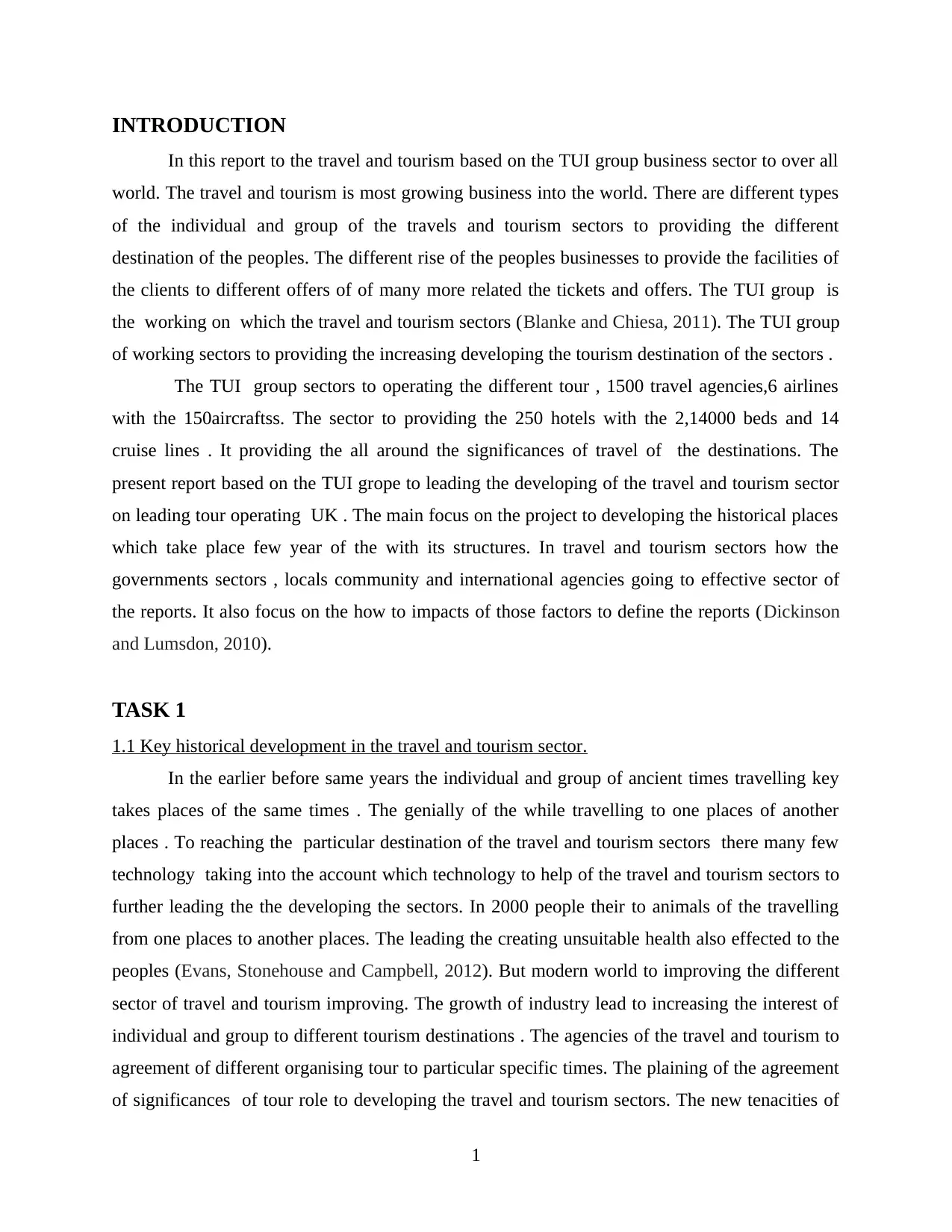
INTRODUCTION
In this report to the travel and tourism based on the TUI group business sector to over all
world. The travel and tourism is most growing business into the world. There are different types
of the individual and group of the travels and tourism sectors to providing the different
destination of the peoples. The different rise of the peoples businesses to provide the facilities of
the clients to different offers of of many more related the tickets and offers. The TUI group is
the working on which the travel and tourism sectors (Blanke and Chiesa, 2011). The TUI group
of working sectors to providing the increasing developing the tourism destination of the sectors .
The TUI group sectors to operating the different tour , 1500 travel agencies,6 airlines
with the 150aircraftss. The sector to providing the 250 hotels with the 2,14000 beds and 14
cruise lines . It providing the all around the significances of travel of the destinations. The
present report based on the TUI grope to leading the developing of the travel and tourism sector
on leading tour operating UK . The main focus on the project to developing the historical places
which take place few year of the with its structures. In travel and tourism sectors how the
governments sectors , locals community and international agencies going to effective sector of
the reports. It also focus on the how to impacts of those factors to define the reports (Dickinson
and Lumsdon, 2010).
TASK 1
1.1 Key historical development in the travel and tourism sector.
In the earlier before same years the individual and group of ancient times travelling key
takes places of the same times . The genially of the while travelling to one places of another
places . To reaching the particular destination of the travel and tourism sectors there many few
technology taking into the account which technology to help of the travel and tourism sectors to
further leading the the developing the sectors. In 2000 people their to animals of the travelling
from one places to another places. The leading the creating unsuitable health also effected to the
peoples (Evans, Stonehouse and Campbell, 2012). But modern world to improving the different
sector of travel and tourism improving. The growth of industry lead to increasing the interest of
individual and group to different tourism destinations . The agencies of the travel and tourism to
agreement of different organising tour to particular specific times. The plaining of the agreement
of significances of tour role to developing the travel and tourism sectors. The new tenacities of
1
In this report to the travel and tourism based on the TUI group business sector to over all
world. The travel and tourism is most growing business into the world. There are different types
of the individual and group of the travels and tourism sectors to providing the different
destination of the peoples. The different rise of the peoples businesses to provide the facilities of
the clients to different offers of of many more related the tickets and offers. The TUI group is
the working on which the travel and tourism sectors (Blanke and Chiesa, 2011). The TUI group
of working sectors to providing the increasing developing the tourism destination of the sectors .
The TUI group sectors to operating the different tour , 1500 travel agencies,6 airlines
with the 150aircraftss. The sector to providing the 250 hotels with the 2,14000 beds and 14
cruise lines . It providing the all around the significances of travel of the destinations. The
present report based on the TUI grope to leading the developing of the travel and tourism sector
on leading tour operating UK . The main focus on the project to developing the historical places
which take place few year of the with its structures. In travel and tourism sectors how the
governments sectors , locals community and international agencies going to effective sector of
the reports. It also focus on the how to impacts of those factors to define the reports (Dickinson
and Lumsdon, 2010).
TASK 1
1.1 Key historical development in the travel and tourism sector.
In the earlier before same years the individual and group of ancient times travelling key
takes places of the same times . The genially of the while travelling to one places of another
places . To reaching the particular destination of the travel and tourism sectors there many few
technology taking into the account which technology to help of the travel and tourism sectors to
further leading the the developing the sectors. In 2000 people their to animals of the travelling
from one places to another places. The leading the creating unsuitable health also effected to the
peoples (Evans, Stonehouse and Campbell, 2012). But modern world to improving the different
sector of travel and tourism improving. The growth of industry lead to increasing the interest of
individual and group to different tourism destinations . The agencies of the travel and tourism to
agreement of different organising tour to particular specific times. The plaining of the agreement
of significances of tour role to developing the travel and tourism sectors. The new tenacities of
1
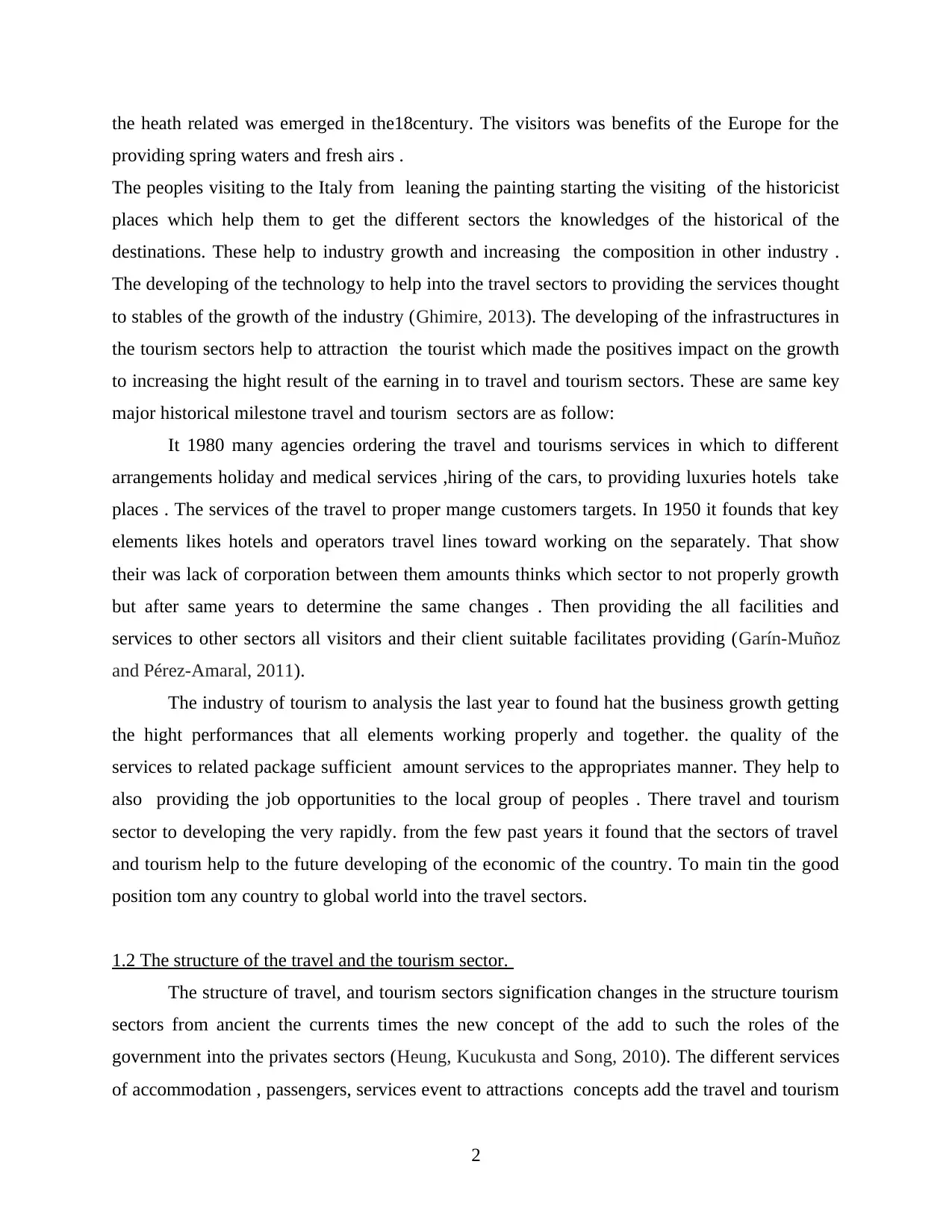
the heath related was emerged in the18century. The visitors was benefits of the Europe for the
providing spring waters and fresh airs .
The peoples visiting to the Italy from leaning the painting starting the visiting of the historicist
places which help them to get the different sectors the knowledges of the historical of the
destinations. These help to industry growth and increasing the composition in other industry .
The developing of the technology to help into the travel sectors to providing the services thought
to stables of the growth of the industry (Ghimire, 2013). The developing of the infrastructures in
the tourism sectors help to attraction the tourist which made the positives impact on the growth
to increasing the hight result of the earning in to travel and tourism sectors. These are same key
major historical milestone travel and tourism sectors are as follow:
It 1980 many agencies ordering the travel and tourisms services in which to different
arrangements holiday and medical services ,hiring of the cars, to providing luxuries hotels take
places . The services of the travel to proper mange customers targets. In 1950 it founds that key
elements likes hotels and operators travel lines toward working on the separately. That show
their was lack of corporation between them amounts thinks which sector to not properly growth
but after same years to determine the same changes . Then providing the all facilities and
services to other sectors all visitors and their client suitable facilitates providing (Garín-Muñoz
and Pérez-Amaral, 2011).
The industry of tourism to analysis the last year to found hat the business growth getting
the hight performances that all elements working properly and together. the quality of the
services to related package sufficient amount services to the appropriates manner. They help to
also providing the job opportunities to the local group of peoples . There travel and tourism
sector to developing the very rapidly. from the few past years it found that the sectors of travel
and tourism help to the future developing of the economic of the country. To main tin the good
position tom any country to global world into the travel sectors.
1.2 The structure of the travel and the tourism sector.
The structure of travel, and tourism sectors signification changes in the structure tourism
sectors from ancient the currents times the new concept of the add to such the roles of the
government into the privates sectors (Heung, Kucukusta and Song, 2010). The different services
of accommodation , passengers, services event to attractions concepts add the travel and tourism
2
providing spring waters and fresh airs .
The peoples visiting to the Italy from leaning the painting starting the visiting of the historicist
places which help them to get the different sectors the knowledges of the historical of the
destinations. These help to industry growth and increasing the composition in other industry .
The developing of the technology to help into the travel sectors to providing the services thought
to stables of the growth of the industry (Ghimire, 2013). The developing of the infrastructures in
the tourism sectors help to attraction the tourist which made the positives impact on the growth
to increasing the hight result of the earning in to travel and tourism sectors. These are same key
major historical milestone travel and tourism sectors are as follow:
It 1980 many agencies ordering the travel and tourisms services in which to different
arrangements holiday and medical services ,hiring of the cars, to providing luxuries hotels take
places . The services of the travel to proper mange customers targets. In 1950 it founds that key
elements likes hotels and operators travel lines toward working on the separately. That show
their was lack of corporation between them amounts thinks which sector to not properly growth
but after same years to determine the same changes . Then providing the all facilities and
services to other sectors all visitors and their client suitable facilitates providing (Garín-Muñoz
and Pérez-Amaral, 2011).
The industry of tourism to analysis the last year to found hat the business growth getting
the hight performances that all elements working properly and together. the quality of the
services to related package sufficient amount services to the appropriates manner. They help to
also providing the job opportunities to the local group of peoples . There travel and tourism
sector to developing the very rapidly. from the few past years it found that the sectors of travel
and tourism help to the future developing of the economic of the country. To main tin the good
position tom any country to global world into the travel sectors.
1.2 The structure of the travel and the tourism sector.
The structure of travel, and tourism sectors signification changes in the structure tourism
sectors from ancient the currents times the new concept of the add to such the roles of the
government into the privates sectors (Heung, Kucukusta and Song, 2010). The different services
of accommodation , passengers, services event to attractions concepts add the travel and tourism
2
Secure Best Marks with AI Grader
Need help grading? Try our AI Grader for instant feedback on your assignments.
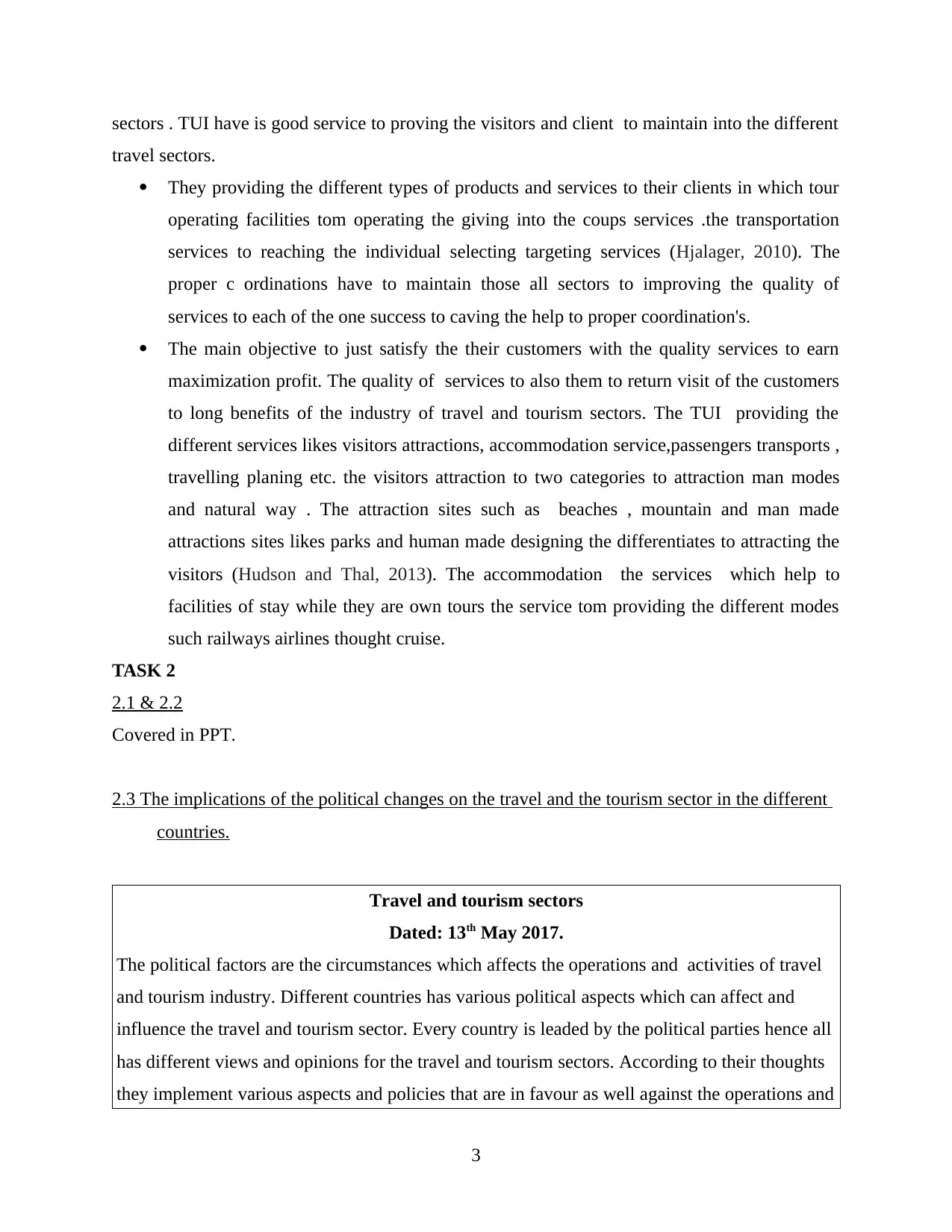
sectors . TUI have is good service to proving the visitors and client to maintain into the different
travel sectors.
They providing the different types of products and services to their clients in which tour
operating facilities tom operating the giving into the coups services .the transportation
services to reaching the individual selecting targeting services (Hjalager, 2010). The
proper c ordinations have to maintain those all sectors to improving the quality of
services to each of the one success to caving the help to proper coordination's.
The main objective to just satisfy the their customers with the quality services to earn
maximization profit. The quality of services to also them to return visit of the customers
to long benefits of the industry of travel and tourism sectors. The TUI providing the
different services likes visitors attractions, accommodation service,passengers transports ,
travelling planing etc. the visitors attraction to two categories to attraction man modes
and natural way . The attraction sites such as beaches , mountain and man made
attractions sites likes parks and human made designing the differentiates to attracting the
visitors (Hudson and Thal, 2013). The accommodation the services which help to
facilities of stay while they are own tours the service tom providing the different modes
such railways airlines thought cruise.
TASK 2
2.1 & 2.2
Covered in PPT.
2.3 The implications of the political changes on the travel and the tourism sector in the different
countries.
Travel and tourism sectors
Dated: 13th May 2017.
The political factors are the circumstances which affects the operations and activities of travel
and tourism industry. Different countries has various political aspects which can affect and
influence the travel and tourism sector. Every country is leaded by the political parties hence all
has different views and opinions for the travel and tourism sectors. According to their thoughts
they implement various aspects and policies that are in favour as well against the operations and
3
travel sectors.
They providing the different types of products and services to their clients in which tour
operating facilities tom operating the giving into the coups services .the transportation
services to reaching the individual selecting targeting services (Hjalager, 2010). The
proper c ordinations have to maintain those all sectors to improving the quality of
services to each of the one success to caving the help to proper coordination's.
The main objective to just satisfy the their customers with the quality services to earn
maximization profit. The quality of services to also them to return visit of the customers
to long benefits of the industry of travel and tourism sectors. The TUI providing the
different services likes visitors attractions, accommodation service,passengers transports ,
travelling planing etc. the visitors attraction to two categories to attraction man modes
and natural way . The attraction sites such as beaches , mountain and man made
attractions sites likes parks and human made designing the differentiates to attracting the
visitors (Hudson and Thal, 2013). The accommodation the services which help to
facilities of stay while they are own tours the service tom providing the different modes
such railways airlines thought cruise.
TASK 2
2.1 & 2.2
Covered in PPT.
2.3 The implications of the political changes on the travel and the tourism sector in the different
countries.
Travel and tourism sectors
Dated: 13th May 2017.
The political factors are the circumstances which affects the operations and activities of travel
and tourism industry. Different countries has various political aspects which can affect and
influence the travel and tourism sector. Every country is leaded by the political parties hence all
has different views and opinions for the travel and tourism sectors. According to their thoughts
they implement various aspects and policies that are in favour as well against the operations and
3

activities of the sectors. The political condition of Libya is not in a good state, it has to solve the
issues so that they can make a favourable condition for the customers to attract at various
destinations. The country is located at a beautiful geographical area where the market of travel
and tourism operations can be effectively carried out. But the political negative aspect of the
nation is affecting the activities to perform in that place. The non Arabic tourists has possessed
the passports with those who are certified legally with the Arabic transactions. The tourism in
this country is considered as a negative things as because it indulges many illegal acts like the
consumptions of alcohol, gambling and harassment acts. Therefore the political decision made
by the government of Libya has affected the travel and tourism sectors very adversely.
The political policies of Asia has supported the travel and tourism sector in the
development and growth in the market. The political leaders considers the sectors as the link
between the nation and the people of the society by helping with various support system. It also
help in making good bond with the neighbour countries. The policies that political party and
the government make can influence the activities and operations of the firm in both negative
and positive manner. It is the duty of the governing body of several country to promote these
sectors so that they can contribute in the development and the growth of the nation as well.
TASK 3
3.1 Factors affecting tourist demands.
There are different types of factors to affected to the travel and tourism demands. There are
different aspects of the factors to influences the demand factors . the essentials parts to which
help to increasing the demand for the particular destination (Lipman and et.al, 2012). There are
various factors to influencing the demand modes follows . Economical . Political , social ,
quality, technology , price, demographical changes,threats, interest rates , insatiability ,taxations,
currency changes . Those all this factors related to the tourism demands , theses are follow:
Quality : The quality factors of packages to also affected the demands . The hight
services quality leading the accommodation facilities of travel and tourism sectors. to
increasing the demand .along with the help of the rise the probability of the business.
Prices : the process is the most factors to affected to the demand of the tourism modes .
General the organizationals can effect to the demand modes of the competently. The
prices are favourable mode it hep to the pricing of the packages helpful of the grating to
4
issues so that they can make a favourable condition for the customers to attract at various
destinations. The country is located at a beautiful geographical area where the market of travel
and tourism operations can be effectively carried out. But the political negative aspect of the
nation is affecting the activities to perform in that place. The non Arabic tourists has possessed
the passports with those who are certified legally with the Arabic transactions. The tourism in
this country is considered as a negative things as because it indulges many illegal acts like the
consumptions of alcohol, gambling and harassment acts. Therefore the political decision made
by the government of Libya has affected the travel and tourism sectors very adversely.
The political policies of Asia has supported the travel and tourism sector in the
development and growth in the market. The political leaders considers the sectors as the link
between the nation and the people of the society by helping with various support system. It also
help in making good bond with the neighbour countries. The policies that political party and
the government make can influence the activities and operations of the firm in both negative
and positive manner. It is the duty of the governing body of several country to promote these
sectors so that they can contribute in the development and the growth of the nation as well.
TASK 3
3.1 Factors affecting tourist demands.
There are different types of factors to affected to the travel and tourism demands. There are
different aspects of the factors to influences the demand factors . the essentials parts to which
help to increasing the demand for the particular destination (Lipman and et.al, 2012). There are
various factors to influencing the demand modes follows . Economical . Political , social ,
quality, technology , price, demographical changes,threats, interest rates , insatiability ,taxations,
currency changes . Those all this factors related to the tourism demands , theses are follow:
Quality : The quality factors of packages to also affected the demands . The hight
services quality leading the accommodation facilities of travel and tourism sectors. to
increasing the demand .along with the help of the rise the probability of the business.
Prices : the process is the most factors to affected to the demand of the tourism modes .
General the organizationals can effect to the demand modes of the competently. The
prices are favourable mode it hep to the pricing of the packages helpful of the grating to
4
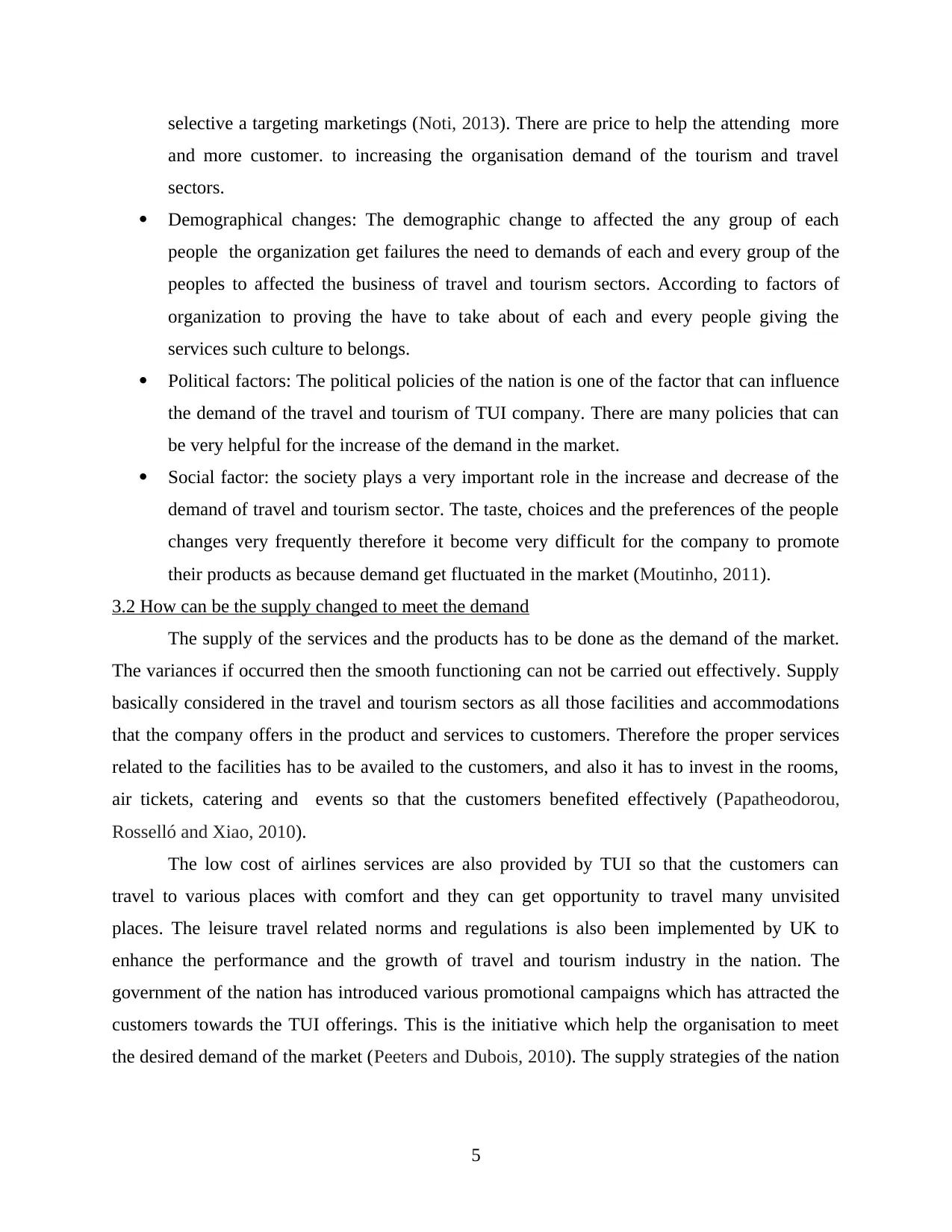
selective a targeting marketings (Noti, 2013). There are price to help the attending more
and more customer. to increasing the organisation demand of the tourism and travel
sectors.
Demographical changes: The demographic change to affected the any group of each
people the organization get failures the need to demands of each and every group of the
peoples to affected the business of travel and tourism sectors. According to factors of
organization to proving the have to take about of each and every people giving the
services such culture to belongs.
Political factors: The political policies of the nation is one of the factor that can influence
the demand of the travel and tourism of TUI company. There are many policies that can
be very helpful for the increase of the demand in the market.
Social factor: the society plays a very important role in the increase and decrease of the
demand of travel and tourism sector. The taste, choices and the preferences of the people
changes very frequently therefore it become very difficult for the company to promote
their products as because demand get fluctuated in the market (Moutinho, 2011).
3.2 How can be the supply changed to meet the demand
The supply of the services and the products has to be done as the demand of the market.
The variances if occurred then the smooth functioning can not be carried out effectively. Supply
basically considered in the travel and tourism sectors as all those facilities and accommodations
that the company offers in the product and services to customers. Therefore the proper services
related to the facilities has to be availed to the customers, and also it has to invest in the rooms,
air tickets, catering and events so that the customers benefited effectively (Papatheodorou,
Rosselló and Xiao, 2010).
The low cost of airlines services are also provided by TUI so that the customers can
travel to various places with comfort and they can get opportunity to travel many unvisited
places. The leisure travel related norms and regulations is also been implemented by UK to
enhance the performance and the growth of travel and tourism industry in the nation. The
government of the nation has introduced various promotional campaigns which has attracted the
customers towards the TUI offerings. This is the initiative which help the organisation to meet
the desired demand of the market (Peeters and Dubois, 2010). The supply strategies of the nation
5
and more customer. to increasing the organisation demand of the tourism and travel
sectors.
Demographical changes: The demographic change to affected the any group of each
people the organization get failures the need to demands of each and every group of the
peoples to affected the business of travel and tourism sectors. According to factors of
organization to proving the have to take about of each and every people giving the
services such culture to belongs.
Political factors: The political policies of the nation is one of the factor that can influence
the demand of the travel and tourism of TUI company. There are many policies that can
be very helpful for the increase of the demand in the market.
Social factor: the society plays a very important role in the increase and decrease of the
demand of travel and tourism sector. The taste, choices and the preferences of the people
changes very frequently therefore it become very difficult for the company to promote
their products as because demand get fluctuated in the market (Moutinho, 2011).
3.2 How can be the supply changed to meet the demand
The supply of the services and the products has to be done as the demand of the market.
The variances if occurred then the smooth functioning can not be carried out effectively. Supply
basically considered in the travel and tourism sectors as all those facilities and accommodations
that the company offers in the product and services to customers. Therefore the proper services
related to the facilities has to be availed to the customers, and also it has to invest in the rooms,
air tickets, catering and events so that the customers benefited effectively (Papatheodorou,
Rosselló and Xiao, 2010).
The low cost of airlines services are also provided by TUI so that the customers can
travel to various places with comfort and they can get opportunity to travel many unvisited
places. The leisure travel related norms and regulations is also been implemented by UK to
enhance the performance and the growth of travel and tourism industry in the nation. The
government of the nation has introduced various promotional campaigns which has attracted the
customers towards the TUI offerings. This is the initiative which help the organisation to meet
the desired demand of the market (Peeters and Dubois, 2010). The supply strategies of the nation
5
Paraphrase This Document
Need a fresh take? Get an instant paraphrase of this document with our AI Paraphraser
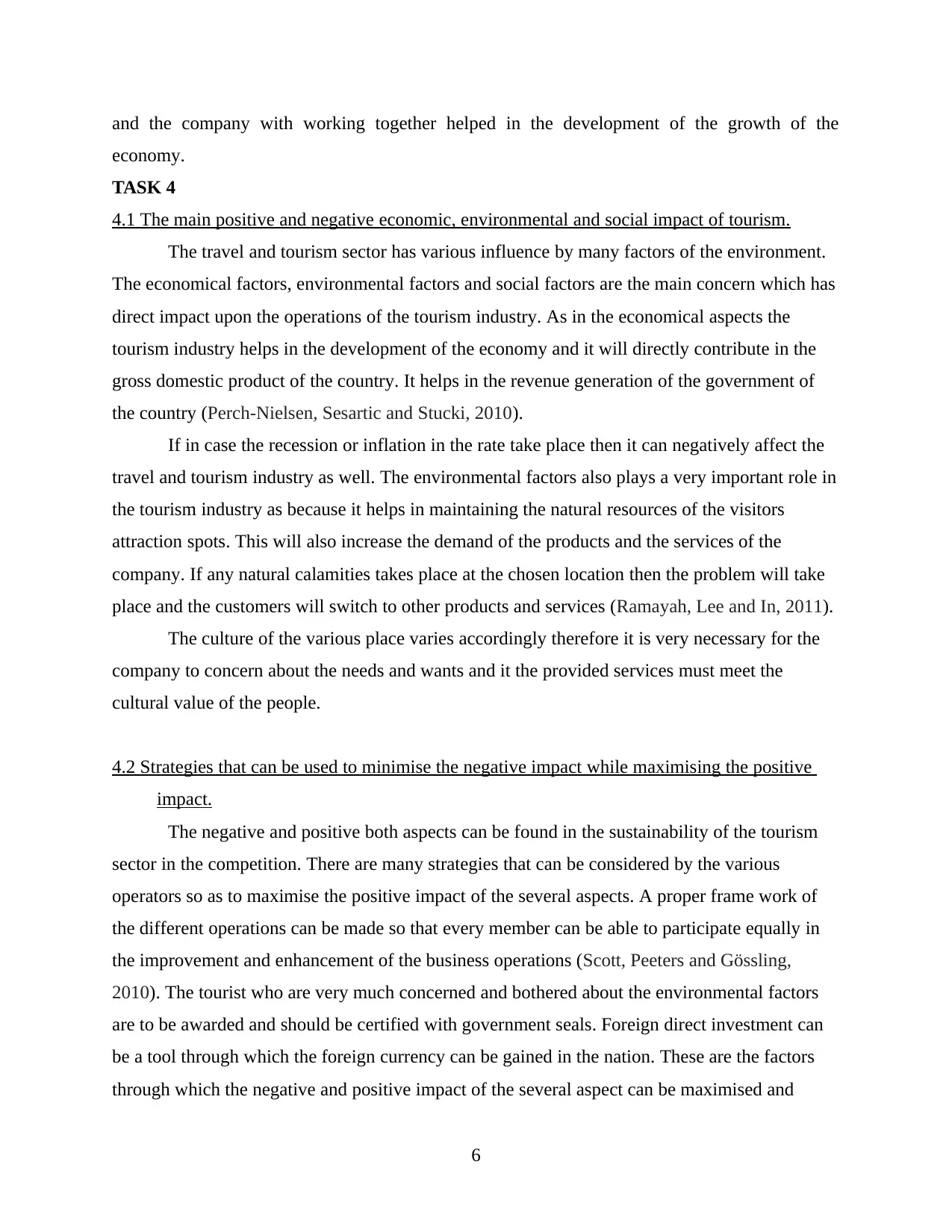
and the company with working together helped in the development of the growth of the
economy.
TASK 4
4.1 The main positive and negative economic, environmental and social impact of tourism.
The travel and tourism sector has various influence by many factors of the environment.
The economical factors, environmental factors and social factors are the main concern which has
direct impact upon the operations of the tourism industry. As in the economical aspects the
tourism industry helps in the development of the economy and it will directly contribute in the
gross domestic product of the country. It helps in the revenue generation of the government of
the country (Perch-Nielsen, Sesartic and Stucki, 2010).
If in case the recession or inflation in the rate take place then it can negatively affect the
travel and tourism industry as well. The environmental factors also plays a very important role in
the tourism industry as because it helps in maintaining the natural resources of the visitors
attraction spots. This will also increase the demand of the products and the services of the
company. If any natural calamities takes place at the chosen location then the problem will take
place and the customers will switch to other products and services (Ramayah, Lee and In, 2011).
The culture of the various place varies accordingly therefore it is very necessary for the
company to concern about the needs and wants and it the provided services must meet the
cultural value of the people.
4.2 Strategies that can be used to minimise the negative impact while maximising the positive
impact.
The negative and positive both aspects can be found in the sustainability of the tourism
sector in the competition. There are many strategies that can be considered by the various
operators so as to maximise the positive impact of the several aspects. A proper frame work of
the different operations can be made so that every member can be able to participate equally in
the improvement and enhancement of the business operations (Scott, Peeters and Gössling,
2010). The tourist who are very much concerned and bothered about the environmental factors
are to be awarded and should be certified with government seals. Foreign direct investment can
be a tool through which the foreign currency can be gained in the nation. These are the factors
through which the negative and positive impact of the several aspect can be maximised and
6
economy.
TASK 4
4.1 The main positive and negative economic, environmental and social impact of tourism.
The travel and tourism sector has various influence by many factors of the environment.
The economical factors, environmental factors and social factors are the main concern which has
direct impact upon the operations of the tourism industry. As in the economical aspects the
tourism industry helps in the development of the economy and it will directly contribute in the
gross domestic product of the country. It helps in the revenue generation of the government of
the country (Perch-Nielsen, Sesartic and Stucki, 2010).
If in case the recession or inflation in the rate take place then it can negatively affect the
travel and tourism industry as well. The environmental factors also plays a very important role in
the tourism industry as because it helps in maintaining the natural resources of the visitors
attraction spots. This will also increase the demand of the products and the services of the
company. If any natural calamities takes place at the chosen location then the problem will take
place and the customers will switch to other products and services (Ramayah, Lee and In, 2011).
The culture of the various place varies accordingly therefore it is very necessary for the
company to concern about the needs and wants and it the provided services must meet the
cultural value of the people.
4.2 Strategies that can be used to minimise the negative impact while maximising the positive
impact.
The negative and positive both aspects can be found in the sustainability of the tourism
sector in the competition. There are many strategies that can be considered by the various
operators so as to maximise the positive impact of the several aspects. A proper frame work of
the different operations can be made so that every member can be able to participate equally in
the improvement and enhancement of the business operations (Scott, Peeters and Gössling,
2010). The tourist who are very much concerned and bothered about the environmental factors
are to be awarded and should be certified with government seals. Foreign direct investment can
be a tool through which the foreign currency can be gained in the nation. These are the factors
through which the negative and positive impact of the several aspect can be maximised and
6
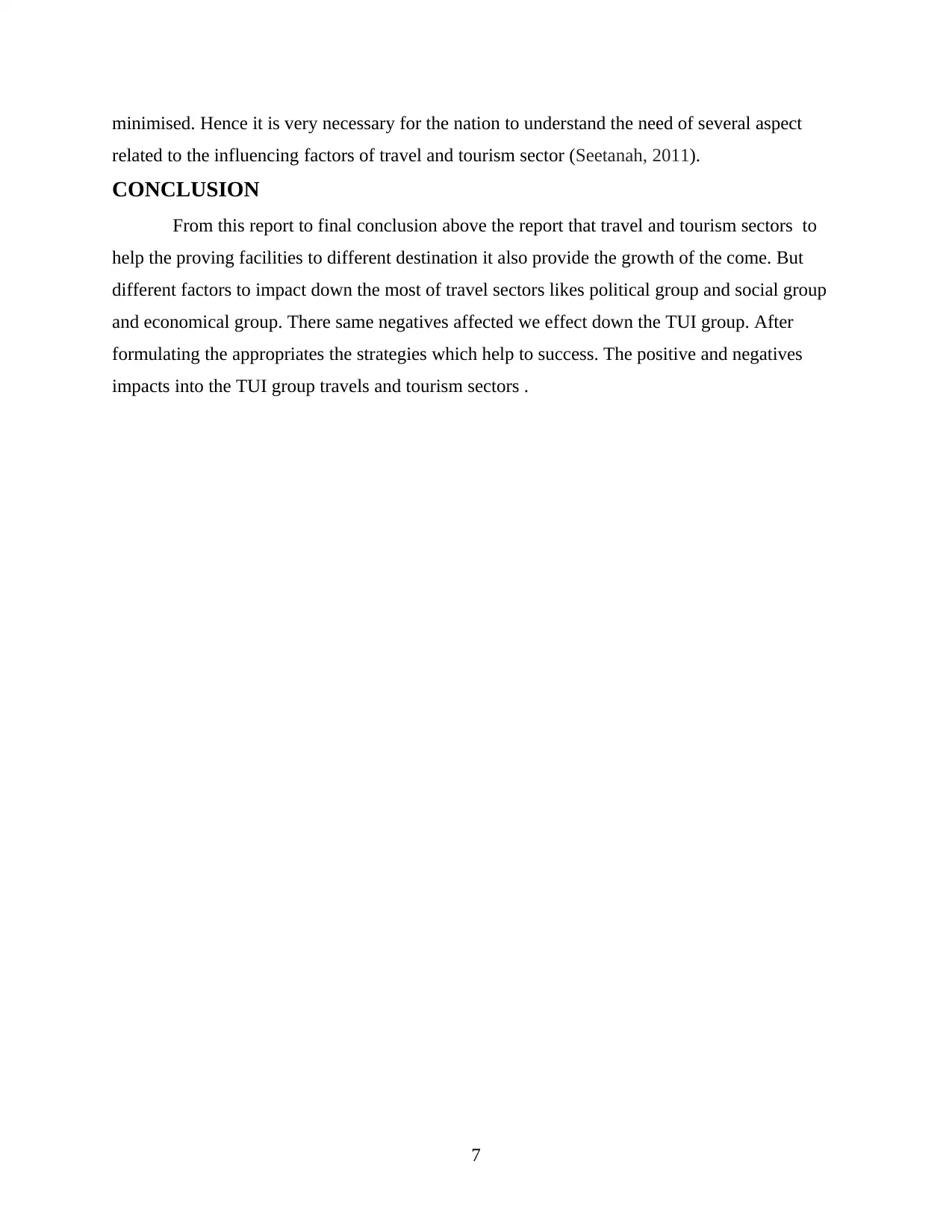
minimised. Hence it is very necessary for the nation to understand the need of several aspect
related to the influencing factors of travel and tourism sector (Seetanah, 2011).
CONCLUSION
From this report to final conclusion above the report that travel and tourism sectors to
help the proving facilities to different destination it also provide the growth of the come. But
different factors to impact down the most of travel sectors likes political group and social group
and economical group. There same negatives affected we effect down the TUI group. After
formulating the appropriates the strategies which help to success. The positive and negatives
impacts into the TUI group travels and tourism sectors .
7
related to the influencing factors of travel and tourism sector (Seetanah, 2011).
CONCLUSION
From this report to final conclusion above the report that travel and tourism sectors to
help the proving facilities to different destination it also provide the growth of the come. But
different factors to impact down the most of travel sectors likes political group and social group
and economical group. There same negatives affected we effect down the TUI group. After
formulating the appropriates the strategies which help to success. The positive and negatives
impacts into the TUI group travels and tourism sectors .
7
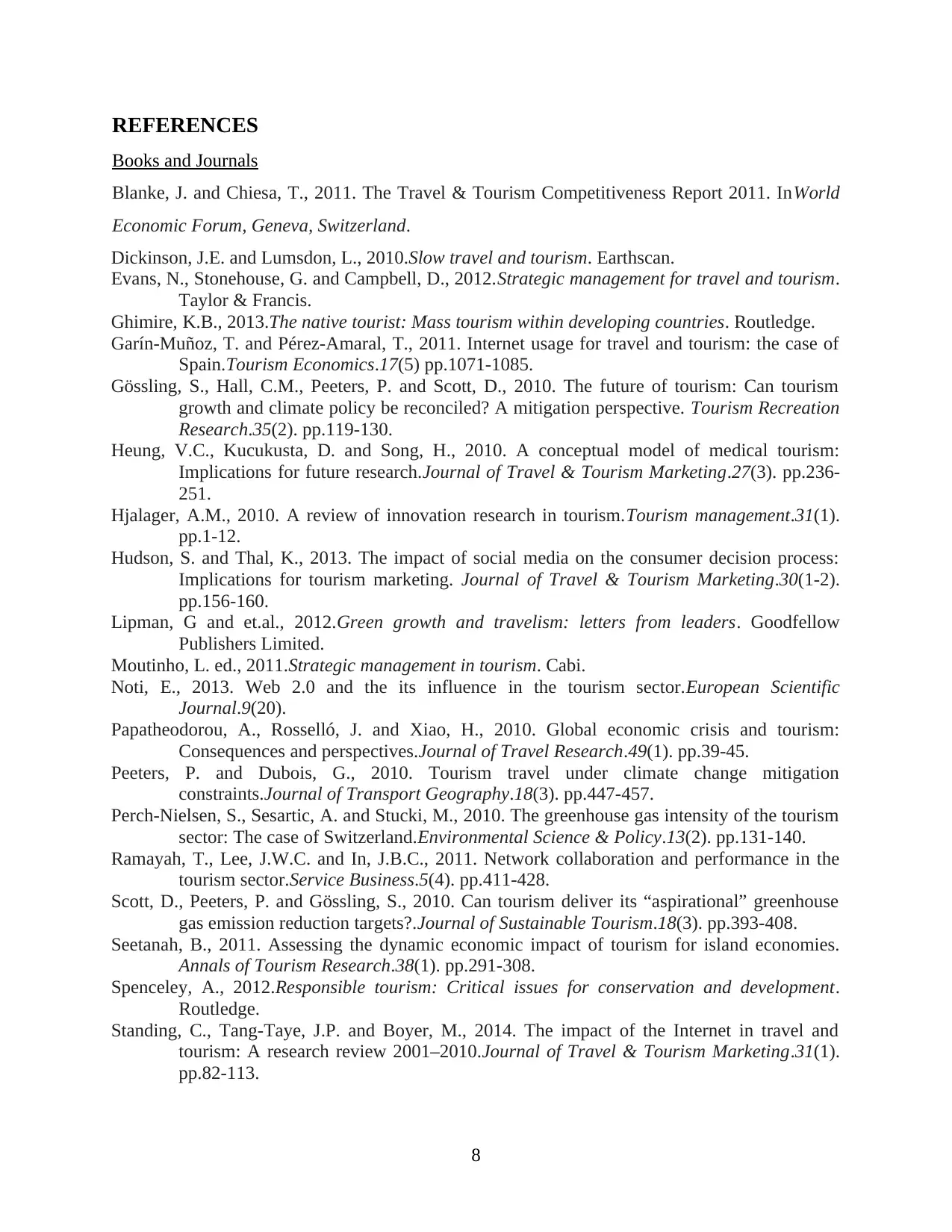
REFERENCES
Books and Journals
Blanke, J. and Chiesa, T., 2011. The Travel & Tourism Competitiveness Report 2011. InWorld
Economic Forum, Geneva, Switzerland.
Dickinson, J.E. and Lumsdon, L., 2010.Slow travel and tourism. Earthscan.
Evans, N., Stonehouse, G. and Campbell, D., 2012.Strategic management for travel and tourism.
Taylor & Francis.
Ghimire, K.B., 2013.The native tourist: Mass tourism within developing countries. Routledge.
Garín-Muñoz, T. and Pérez-Amaral, T., 2011. Internet usage for travel and tourism: the case of
Spain.Tourism Economics.17(5) pp.1071-1085.
Gössling, S., Hall, C.M., Peeters, P. and Scott, D., 2010. The future of tourism: Can tourism
growth and climate policy be reconciled? A mitigation perspective. Tourism Recreation
Research.35(2). pp.119-130.
Heung, V.C., Kucukusta, D. and Song, H., 2010. A conceptual model of medical tourism:
Implications for future research.Journal of Travel & Tourism Marketing.27(3). pp.236-
251.
Hjalager, A.M., 2010. A review of innovation research in tourism.Tourism management.31(1).
pp.1-12.
Hudson, S. and Thal, K., 2013. The impact of social media on the consumer decision process:
Implications for tourism marketing. Journal of Travel & Tourism Marketing.30(1-2).
pp.156-160.
Lipman, G and et.al., 2012.Green growth and travelism: letters from leaders. Goodfellow
Publishers Limited.
Moutinho, L. ed., 2011.Strategic management in tourism. Cabi.
Noti, E., 2013. Web 2.0 and the its influence in the tourism sector.European Scientific
Journal.9(20).
Papatheodorou, A., Rosselló, J. and Xiao, H., 2010. Global economic crisis and tourism:
Consequences and perspectives.Journal of Travel Research.49(1). pp.39-45.
Peeters, P. and Dubois, G., 2010. Tourism travel under climate change mitigation
constraints.Journal of Transport Geography.18(3). pp.447-457.
Perch-Nielsen, S., Sesartic, A. and Stucki, M., 2010. The greenhouse gas intensity of the tourism
sector: The case of Switzerland.Environmental Science & Policy.13(2). pp.131-140.
Ramayah, T., Lee, J.W.C. and In, J.B.C., 2011. Network collaboration and performance in the
tourism sector.Service Business.5(4). pp.411-428.
Scott, D., Peeters, P. and Gössling, S., 2010. Can tourism deliver its “aspirational” greenhouse
gas emission reduction targets?.Journal of Sustainable Tourism.18(3). pp.393-408.
Seetanah, B., 2011. Assessing the dynamic economic impact of tourism for island economies.
Annals of Tourism Research.38(1). pp.291-308.
Spenceley, A., 2012.Responsible tourism: Critical issues for conservation and development.
Routledge.
Standing, C., Tang-Taye, J.P. and Boyer, M., 2014. The impact of the Internet in travel and
tourism: A research review 2001–2010.Journal of Travel & Tourism Marketing.31(1).
pp.82-113.
8
Books and Journals
Blanke, J. and Chiesa, T., 2011. The Travel & Tourism Competitiveness Report 2011. InWorld
Economic Forum, Geneva, Switzerland.
Dickinson, J.E. and Lumsdon, L., 2010.Slow travel and tourism. Earthscan.
Evans, N., Stonehouse, G. and Campbell, D., 2012.Strategic management for travel and tourism.
Taylor & Francis.
Ghimire, K.B., 2013.The native tourist: Mass tourism within developing countries. Routledge.
Garín-Muñoz, T. and Pérez-Amaral, T., 2011. Internet usage for travel and tourism: the case of
Spain.Tourism Economics.17(5) pp.1071-1085.
Gössling, S., Hall, C.M., Peeters, P. and Scott, D., 2010. The future of tourism: Can tourism
growth and climate policy be reconciled? A mitigation perspective. Tourism Recreation
Research.35(2). pp.119-130.
Heung, V.C., Kucukusta, D. and Song, H., 2010. A conceptual model of medical tourism:
Implications for future research.Journal of Travel & Tourism Marketing.27(3). pp.236-
251.
Hjalager, A.M., 2010. A review of innovation research in tourism.Tourism management.31(1).
pp.1-12.
Hudson, S. and Thal, K., 2013. The impact of social media on the consumer decision process:
Implications for tourism marketing. Journal of Travel & Tourism Marketing.30(1-2).
pp.156-160.
Lipman, G and et.al., 2012.Green growth and travelism: letters from leaders. Goodfellow
Publishers Limited.
Moutinho, L. ed., 2011.Strategic management in tourism. Cabi.
Noti, E., 2013. Web 2.0 and the its influence in the tourism sector.European Scientific
Journal.9(20).
Papatheodorou, A., Rosselló, J. and Xiao, H., 2010. Global economic crisis and tourism:
Consequences and perspectives.Journal of Travel Research.49(1). pp.39-45.
Peeters, P. and Dubois, G., 2010. Tourism travel under climate change mitigation
constraints.Journal of Transport Geography.18(3). pp.447-457.
Perch-Nielsen, S., Sesartic, A. and Stucki, M., 2010. The greenhouse gas intensity of the tourism
sector: The case of Switzerland.Environmental Science & Policy.13(2). pp.131-140.
Ramayah, T., Lee, J.W.C. and In, J.B.C., 2011. Network collaboration and performance in the
tourism sector.Service Business.5(4). pp.411-428.
Scott, D., Peeters, P. and Gössling, S., 2010. Can tourism deliver its “aspirational” greenhouse
gas emission reduction targets?.Journal of Sustainable Tourism.18(3). pp.393-408.
Seetanah, B., 2011. Assessing the dynamic economic impact of tourism for island economies.
Annals of Tourism Research.38(1). pp.291-308.
Spenceley, A., 2012.Responsible tourism: Critical issues for conservation and development.
Routledge.
Standing, C., Tang-Taye, J.P. and Boyer, M., 2014. The impact of the Internet in travel and
tourism: A research review 2001–2010.Journal of Travel & Tourism Marketing.31(1).
pp.82-113.
8
Secure Best Marks with AI Grader
Need help grading? Try our AI Grader for instant feedback on your assignments.
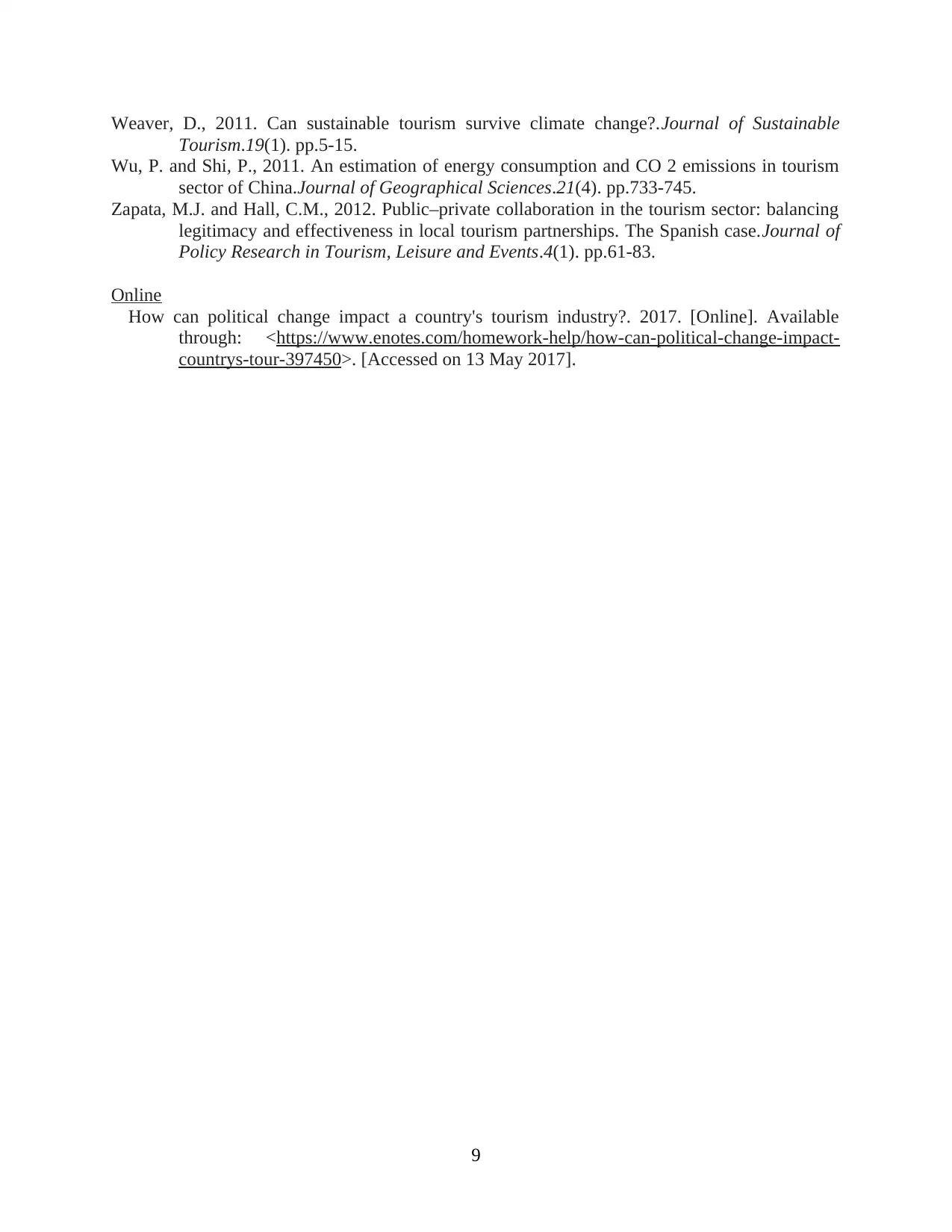
Weaver, D., 2011. Can sustainable tourism survive climate change?.Journal of Sustainable
Tourism.19(1). pp.5-15.
Wu, P. and Shi, P., 2011. An estimation of energy consumption and CO 2 emissions in tourism
sector of China.Journal of Geographical Sciences.21(4). pp.733-745.
Zapata, M.J. and Hall, C.M., 2012. Public–private collaboration in the tourism sector: balancing
legitimacy and effectiveness in local tourism partnerships. The Spanish case.Journal of
Policy Research in Tourism, Leisure and Events.4(1). pp.61-83.
Online
How can political change impact a country's tourism industry?. 2017. [Online]. Available
through: <https://www.enotes.com/homework-help/how-can-political-change-impact-
countrys-tour-397450>. [Accessed on 13 May 2017].
9
Tourism.19(1). pp.5-15.
Wu, P. and Shi, P., 2011. An estimation of energy consumption and CO 2 emissions in tourism
sector of China.Journal of Geographical Sciences.21(4). pp.733-745.
Zapata, M.J. and Hall, C.M., 2012. Public–private collaboration in the tourism sector: balancing
legitimacy and effectiveness in local tourism partnerships. The Spanish case.Journal of
Policy Research in Tourism, Leisure and Events.4(1). pp.61-83.
Online
How can political change impact a country's tourism industry?. 2017. [Online]. Available
through: <https://www.enotes.com/homework-help/how-can-political-change-impact-
countrys-tour-397450>. [Accessed on 13 May 2017].
9
1 out of 11
Related Documents
Your All-in-One AI-Powered Toolkit for Academic Success.
+13062052269
info@desklib.com
Available 24*7 on WhatsApp / Email
![[object Object]](/_next/static/media/star-bottom.7253800d.svg)
Unlock your academic potential
© 2024 | Zucol Services PVT LTD | All rights reserved.





